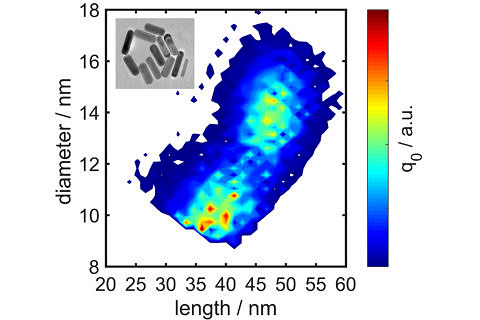A golden age for particle analysis

FAU researchers develop a process to measure nanorods quickly and accurately
Process engineers at FAU have developed a method which allows the size and shape of nanoparticles in dispersions to be determined considerably quicker than ever before. Based on gold nanorods, they demonstrated how length and diameter distributions can be measured accurately in just one step instead of the complicated series of electron microscopic images which have been needed up until now. Nanoparticles from precious metals are used, for example, as catalysts and contrast agents for diagnosing cancer. The results have been published in the renowned journal Nature Communications (doi: 10.1038/s41467-018-07366-9).
Even in the Middle Ages, gold particles were used to create vibrant red and blue colours, for example to illustrate biblical scenes in stained glass windows. This effect is caused by the interaction between the electromagnetic fields of the incoming light with the electrons in the metal which are made to vibrate collectively. Nowadays, nanoparticles of gold or silver are of interest for applications in biotechnology and as catalysts whilst their optical properties are also still being used, for example for medical imaging purposes, where they act as a contrast agent for diagnosing tumours. The particles are synthesised specially for the various purposes, as their properties depend on their size, shape, surface, inner structure and composition.
Monitoring this synthesis process is very complex: whilst it is relatively straightforward to determine the size of the nanoparticles using optical measuring techniques, a great many electron microscopic images have to be analysed in a detailed and time-consuming process before the shape of the particle can be determined. This hinders the development of new manufacturing and processing methods, as time-consuming measurements are needed to keep track of any changes to the size or properties of the particles.
Determining size and shape in just one step
Together with working groups from the field of mathematics led by Dr. Lukas Pflug and Prof. Dr. Michael Stingl, Professorship of Mathematical Optimisation, and physical chemistry, led by Prof. Dr. Carola Kryschi, Chair of Physical Chemistry, process engineers at FAU led by Simon Wawra and Prof. Dr. Wolfgang Peukert, Chair of Particle Technology, have developed a new method for measuring the length and diameter distribution of plasmonic gold nanorods in one single experiment. In a first step, the particles are dispersed in water in an ultrasonic bath and made to sink using centrifugation. At the same time they are targeted with flashes of light and their spectral properties recorded using a detector. ‘By combining multi-wavelength absorption optics and analytical ultracentrifugation, we were able to measure the optical and sedimentary properties of the nanorods simultaneously,’ explains Prof. Dr. Wolfgang Peukert. The researchers based their analysis method on the fact that both sedimentation speed and strength of light absorption depend on the diameter and length of nanorods. ‘The distribution of length, diameter, aspect ratio, surface and volume can be derived directly as a result,’ explains Wolfgang Peukert.
Method can also be used for particles of other shapes
The method developed at FAU is not only restricted to nanoparticles made of precious metals. It can be used on a number of plasmonically active materials and can also be extended to other geometric shapes. During synthesis, sphere-shaped particles are created at the same time as nanorods, and their distribution and percentage by mass in the sample can also be measured accurately. Peukert: ‘Our new method allows a comprehensive and quantitative analysis of these highly interesting particle systems. We believe that our work will contribute to being able to characterise plasmonic nanoparticles rapidly and reliably during synthesis and in a number of applications.’
- doi: 10.1038/s41467-018-07366-9
- ‘Determination of the two-dimensional distributions of gold nanorods by multiwavelength analytical ultracentrifugation’
Further information:
Prof. Dr. Wolfgang Peukert
Phone: +49 9131 8529400
wolfgang.peukert@fau.de
www.fps.fau.de/facilities/analytical-ultracentrifugation